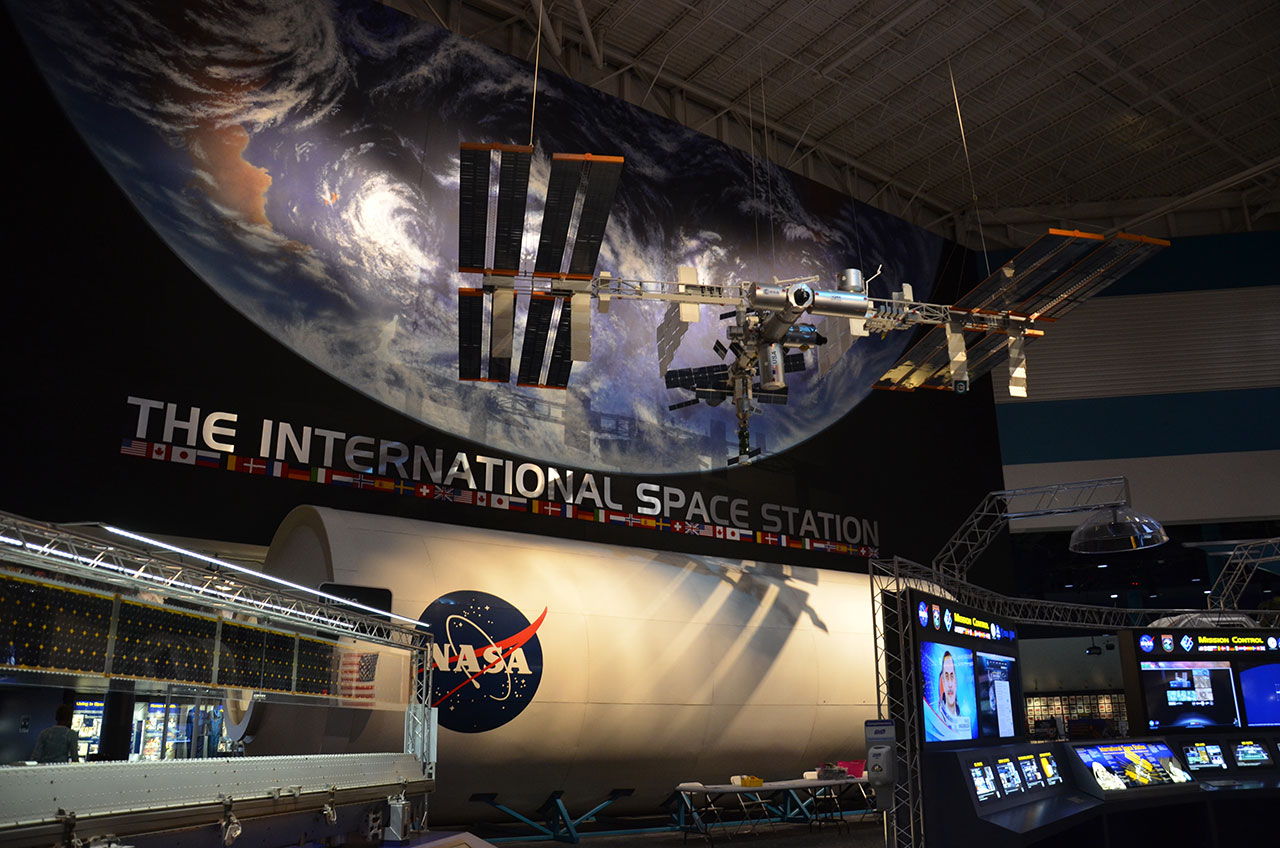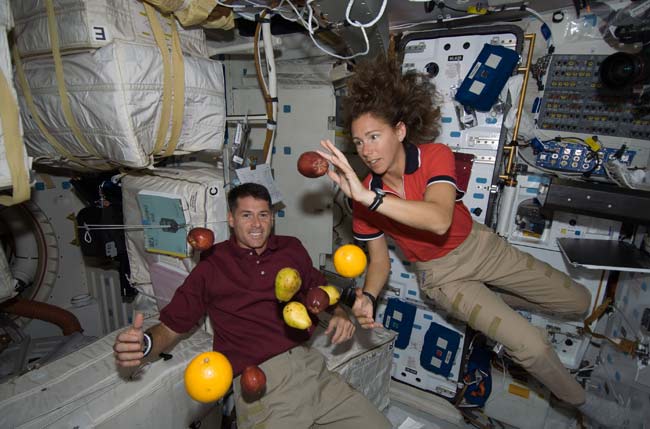Space Station Lands in Houston in State-of-the-Art NASA Exhibit

NASA has a new "stage" to expose and educate the public about the work behind — and on board — the International Space Station.
More than a year in the making, NASA and Space Center Houston, the visitor center for the agency's Johnson Space Center in Texas, put the final touches on a new interactive exhibit and special effects live stage show that highlights how the orbiting outpost came to be, what life is like on board and how it is being used to conduct science.
The 3000-square-foot (280 square meters) display was inspired by NASA's traveling exhibit "Destination Station" (hosted currently at Atlanta's Fernbank Science Center until May 18). But instead of simply recreating the mobile exhibition, NASA's International Space Station Program worked with the external relations office at Johnson and Space Center Houston to enhance and expand the display into a brand-new experience for guests. [Building the International Space Station (Photos)]
"This [new] exhibition highlights, through the use of a live performance, static graphic elements, hardware, astronaut personal effects, video content and interactive software programs, the international partnership which assembled this orbiting laboratory, its human presence which works and lives on board, and the complex research and science that is taking place which benefits all humankind," NASA wrote about the exhibit.
Destination Station 2.0
Space Center Houston began building the exhibit about a year ago by reconfiguring the International Space Station — or rather a large detailed model of the orbiting complex.
Suspended from the ceiling, the scale model was updated to reflect the final assembly of the space station, including removing a once-docked replica of the now-retired space shuttle. The model was then re-hung in front of a mural of the Earth, placing it into the context of the new display.
Get the Space.com Newsletter
Breaking space news, the latest updates on rocket launches, skywatching events and more!
Underneath the not-so-miniature station is a new mockup of a Mission Control console. Nearby, one of the canisters used to transport the orbiting laboratory's power-providing solar arrays is also on display with a sample strip of the cells used to generate electricity for the station.
The Mission Control monitors display the "Space Station Live!" website, which provides access to live data from the real space station as received through the real Mission Control, located nearby at the Johnson Space Center. Not only can visitors use the replica console to learn what the astronauts and cosmonauts on board the station are doing in space in real time, but they can find when the orbiting complex can be seen flying over their homes.
Venturing further into the exhibit, guests can see a training mockup of the space station's multi-window Cupola, a full-size model of the outpost's robotic resident Robonaut 2, and look inside both a crew member's living quarters and the onboard waste containment system, or toilet.
Wall-size video displays introduce the public to the many science racks that support the hundreds of experiments being hosted on board the space station at any one time and to the equipment used by the astronauts to first build and now maintain the complex.
At the center of the new display are two large glass cases that showcase artifacts from the space station's first 15 years in orbit. One case exhibits test samples and a flown hatch cover that show the impact, literally, that micrometeoroid debris has on the outpost's exterior.
The second case features crewmembers' clothing and personal items, on loan from the astronauts themselves. Included in the display are the tennis balls used in the first attempt at juggling in orbit, a small pink romper flown for an astronaut whose baby girl was to be born while he was in space, and a costume shirt from the television series "Star Trek: The Next Generation" that was worn by a crewmember on board the real-life space station.

The (special) effects of life in space
Where the new exhibit really comes alive is during a live stage show about what life is like for astronauts on board the space station.
Set on a stage designed to look like the inside of a space station module, Space Center Houston's "Mission Briefing Officers" guide guests through how astronauts eat, sleep and work aboard the orbiting laboratory.
The "Living in Space" show pre-dates the new exhibit but has been enhanced with state-of-the-art special effects to match the high-tech design of the surrounding display.
"The storyline is still how do the astronauts eat, sleep in space, how do they exercise, they go to the bathroom and what kind of work they do. That part hasn't changed but the way that we tell that story has," Paul Spana, exhibits manager at Space Center Houston, told collectSPACE.com.
"What is brand-new about the show, and what I think is the coolest part, is this new special effect," Spana said. "The visitor does not see the equipment, but in the ceiling we have two large video projectors and it is a technique called 'video mapping.' The back wall of the module is actually a projection screen."
Similar to the effects featured in the "Harry Potter and the Forbidden Journey" ride at Universal Studios Orlando in Florida, the projection technology creates the appearance that the drawers aboard the space station are opening and that items are able to float out. At one point, water globules, seemingly weightless, even float across the stage and are "absorbed" by a real-life towel.
Visiting the space station
The new International Space Station exhibit, which is now open for the public to experience, is included with regular admission to Space Center Houston.
It's a permanent exhibition, and NASA and Space Center Houston plan to continue expanding the display, showcasing the latest developments aboard the space station, as well as adding more flown and astronaut artifacts as they become available.
"You can come here and find out who those people are that are in space today, you can find out about what they are doing, you can find out how to see the space station from your own backyard and then you can learn why we are doing all of this," Spana said.
See collectSPACE.com for more photographs of NASA’s and Space Center Houston’s new International Space Station exhibit.
Follow collectSPACE.com on Facebook and on Twitter at @collectSPACE. Copyright 2013 collectSPACE.com. All rights reserved.
Join our Space Forums to keep talking space on the latest missions, night sky and more! And if you have a news tip, correction or comment, let us know at: community@space.com.

Robert Pearlman is a space historian, journalist and the founder and editor of collectSPACE.com, a daily news publication and community devoted to space history with a particular focus on how and where space exploration intersects with pop culture. Pearlman is also a contributing writer for Space.com and co-author of "Space Stations: The Art, Science, and Reality of Working in Space” published by Smithsonian Books in 2018.In 2009, he was inducted into the U.S. Space Camp Hall of Fame in Huntsville, Alabama. In 2021, he was honored by the American Astronautical Society with the Ordway Award for Sustained Excellence in Spaceflight History. In 2023, the National Space Club Florida Committee recognized Pearlman with the Kolcum News and Communications Award for excellence in telling the space story along the Space Coast and throughout the world.










